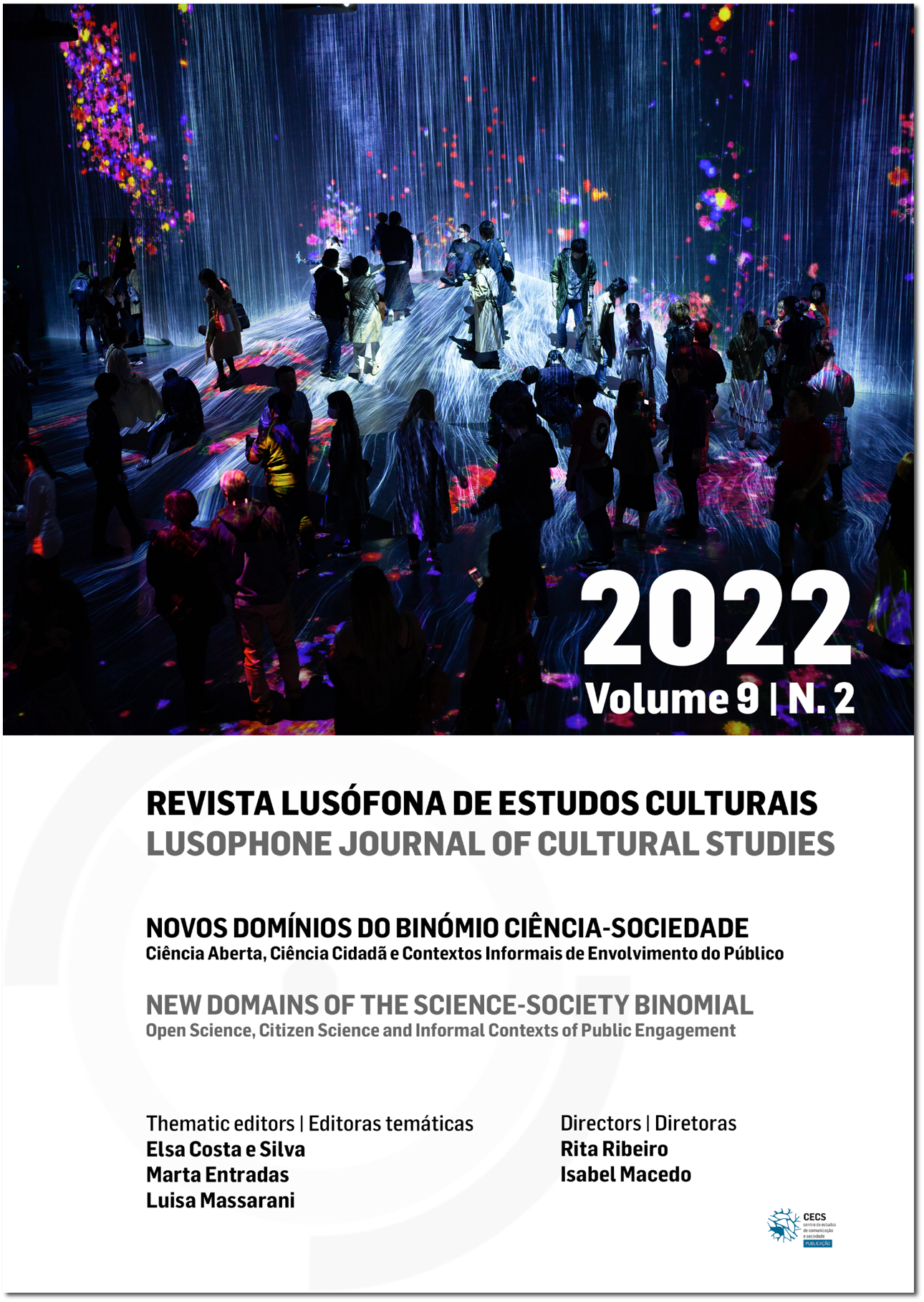The Ladder of Power: Science Communication and Citizen Science
DOI:
https://doi.org/10.21814/rlec.4059Keywords:
participatory science communication, citizen science, ladder of participationAbstract
On March 28, 2022, the Journal of Science Communication published a special issue on participatory science communication featuring 15 papers and essays. The Journal of Science Communication special issue sparked a debate among the four editors over the wording of the call for papers. What is the difference between “participatory science communication” and “citizen science”? Are they different points along a continuum stretching from “simple” to “more involved”? Does “citizen science” incorporate “participatory science communication”? And is all citizen science participatory? A key consideration is the level of involvement by “citizens” in these endeavours, and that consideration translates to questions of power. This essay explores definitions of participatory science communication and citizen science. It examines each of these concepts through the framework of shifting relationships and the implicit power imbalance between scientists and various publics. In doing this, we revisited Sherry Arnstein’s (1969) paper, “A Ladder of Citizen Participation”, and constructed complementary ladders for science communication and citizen science.
Downloads
References
Arnstein, S. R. (1969). A ladder of citizen participation. Journal of the American Institute of Planners, 35, 216–224. https://doi.org/10.1080/01944366908977225 DOI: https://doi.org/10.1080/01944366908977225
Ayure, M., & Triana, R. (2022). Participatory science communication for transformation in Colombia. Journal of Science Communication, 21(2), 1–12. https://doi.org/10.22323/2.21020403 DOI: https://doi.org/10.22323/2.21020403
Barbosa, L., del Cañizo, C., & Revuelta, G. (2022). Participatory citizen science in solar energy research: Going beyond data collection to promote the energy transition. Journal of Science Communication, 21(2), 1–9. https://doi.org/10.22323/2.21020806 DOI: https://doi.org/10.22323/2.21020806
Bonney, R., Cooper, C. B., Dickinson, J., Kelling, S., Phillips, T., Rosenberg, K. V., & Shirk, J. (2009). Citizen science: A developing tool for expanding science knowledge and scientific literacy. BioScience, 59(11), 977–984. https://doi.org/10.1525/bio.2009.59.11.9 DOI: https://doi.org/10.1525/bio.2009.59.11.9
Campos, R. (2022). Including younger children in science-related issues using participatory and collaborative strategies: A pilot project on urban biodiversity. Journal of Science Communication, 21(2), 1–16. https://doi.org/10.22323/2.21020807 DOI: https://doi.org/10.22323/2.21020807
Cornell Lab. (n.d.). Rick Bonney. The Cornell Lab of Ornithology. https://www.birds.cornell.edu/home/staff/rick-bonney/
Friedman, R., & Rosen, G. (2021). David vs. Goliath? Leveraging citizen science in Israel’s energy debates. Energy Research & Social Science, 71, 1–9. https://doi.org/10.1016/j.erss.2020.101797 DOI: https://doi.org/10.1016/j.erss.2020.101797
Hecker, S., Haklay, M., Bowser, A., Makuch, Z., Vogel, J., & Bonn, A. (2018). Innovation in open science, society and policy – Setting the agenda for citizen science. In S. Hecker, M. Haklay, A. Bowser, Z. Makuch, J. Vogel, & A. Bonn (Eds.), Citizen science: Innovation in open science, society and policy (pp. 1–24). UCL Press. DOI: https://doi.org/10.2307/j.ctv550cf2.8
Holliman, R., Adams, A., Blackman, T., Collins, T., Davies, G., Dibb, S., Grand, A., Holti, R., McKerlie, F., Mahony, N., & Wissenburg, A. (2015). An open research university: Final report. The Open University. http://oro.open.ac.uk/44255/
Irwin, A. (1995). Citizen science: A study of people, expertise and sustainable development (1st ed.). Routledge. https://doi.org/10.4324/9780203202395 DOI: https://doi.org/10.4324/9780203202395
Leitch, A. (2022). Participatory science communication needs to consider power, place, pain and ‘poisson’: A practitioner insight. Journal of Science Communication, 21(2), 1–15. https://doi.org/10.22323/2.21020801 DOI: https://doi.org/10.22323/2.21020801
Lin, C. (2022). Emergence of perceptions of smart agriculture at a community/campus farm: A participatory experience. Journal of Science Communication, 21(2), 1–15. https://doi.org/10.22323/2.21020202 DOI: https://doi.org/10.22323/2.21020202
Metcalfe, J. (2019). Comparing science communication theory with practice: An assessment and critique using Australian data. Public Understanding of Science, 28(4), 382–400. https://doi.org/10.1177%2F0963662518821022 DOI: https://doi.org/10.1177/0963662518821022
Metcalfe, J. (2022). Comparing science communication theory with participatory practice: Case study of the Australian Climate Champion Program. Journal of Science Communication, 21(2), 1–23. https://doi.org/10.22323/2.21020204 DOI: https://doi.org/10.22323/2.21020204
Metcalfe, J., Gascoigne, T., Medvecky, F., & Nepote, A. C. (2022). Participatory science communication for transformation. Journal of Science Communication, 21(2), 1–11. https://doi.org/10.22323/2.21020501 DOI: https://doi.org/10.22323/2.21020501
Organizing Engagement. (n.d.). Models: Ladder of citizen participation. https://organizingengagement.org/models/ladder-of-citizen-participation/
Robinson, L. D., Cawthray, J. L., West, S. E., Bonn, A., & Ansine, J. (2018). Ten principles of citizen science. In S. Hecker, M. Haklay, A. Bowser, Z. Makuch, J. Vogel, & A. Bonn (Eds.), Citizen science: Innovation in open science, society and policy (pp. 27–40). UCL Press. DOI: https://doi.org/10.2307/j.ctv550cf2.9
Smallman, M. L., Lock, S., & Miller, S. (2020) United Kingdom: The developing relationship between science and society. In T. Gascoigne, B. Lewenstein, L. Massarani, B. Schiele, P. Broks, M. Riedlinger, & J. Leach (Eds.), Communicating science: A global perspective (pp. 931–958). ANU (Australian National University) Press. https://doi.org/10.22459/CS.2020 DOI: https://doi.org/10.22459/CS.2020
Standerfer, C., Loker, E., & Lochmann, J. (2022). Look before you leap: Assessing community readiness for action on science and health policy issues. Journal of Science Communication, 21(2), 1–12. https://doi.org/10.22323/2.21020803 DOI: https://doi.org/10.22323/2.21020803
Thomas, V., & Cassidy, A. (2022). Practicing engaged research through pandemic times: Do not feed the animals? Journal of Science Communication, 21(2), 1–20. https://doi.org/10.22323/2.21020205 DOI: https://doi.org/10.22323/2.21020205
Downloads
Published
How to Cite
Issue
Section
License
Copyright (c) 2022 Thomas Gascoigne, Jenni Metcalfe, Michelle Riedlinger

This work is licensed under a Creative Commons Attribution 4.0 International License.
Authors own the copyright, providing the journal with the right of first publication. The work is licensed under a Creative Commons - Atribuição 4.0 Internacional License.












